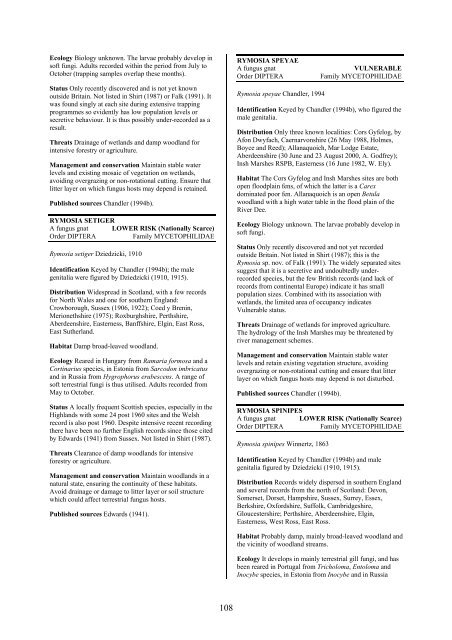Part 2: Nematocera and Aschiza not dealt with by Falk (1991) - JNCC
Part 2: Nematocera and Aschiza not dealt with by Falk (1991) - JNCC
Part 2: Nematocera and Aschiza not dealt with by Falk (1991) - JNCC
You also want an ePaper? Increase the reach of your titles
YUMPU automatically turns print PDFs into web optimized ePapers that Google loves.
Ecology Biology unknown. The larvae probably develop in<br />
soft fungi. Adults recorded <strong>with</strong>in the period from July to<br />
October (trapping samples overlap these months).<br />
Status Only recently discovered <strong>and</strong> is <strong>not</strong> yet known<br />
outside Britain. Not listed in Shirt (1987) or <strong>Falk</strong> (<strong>1991</strong>). It<br />
was found singly at each site during extensive trapping<br />
programmes so evidently has low population levels or<br />
secretive behaviour. It is thus possibly under-recorded as a<br />
result.<br />
Threats Drainage of wetl<strong>and</strong>s <strong>and</strong> damp woodl<strong>and</strong> for<br />
intensive forestry or agriculture.<br />
Management <strong>and</strong> conservation Maintain stable water<br />
levels <strong>and</strong> existing mosaic of vegetation on wetl<strong>and</strong>s,<br />
avoiding overgrazing or non-rotational cutting. Ensure that<br />
litter layer on which fungus hosts may depend is retained.<br />
Published sources Ch<strong>and</strong>ler (1994b).<br />
RYMOSIA SETIGER<br />
A fungus gnat LOWER RISK (Nationally Scarce)<br />
Order DIPTERA<br />
Family MYCETOPHILIDAE<br />
Rymosia setiger Dziedzicki, 1910<br />
Identification Keyed <strong>by</strong> Ch<strong>and</strong>ler (1994b); the male<br />
genitalia were figured <strong>by</strong> Dziedzicki (1910, 1915).<br />
Distribution Widespread in Scotl<strong>and</strong>, <strong>with</strong> a few records<br />
for North Wales <strong>and</strong> one for southern Engl<strong>and</strong>:<br />
Crowborough, Sussex (1906, 1922); Coed y Brenin,<br />
Merionethshire (1975); Roxburghshire, Perthshire,<br />
Aberdeenshire, Easterness, Banffshire, Elgin, East Ross,<br />
East Sutherl<strong>and</strong>.<br />
Habitat Damp broad-leaved woodl<strong>and</strong>.<br />
Ecology Reared in Hungary from Ramaria formosa <strong>and</strong> a<br />
Cortinarius species, in Estonia from Sarcodon imbricatus<br />
<strong>and</strong> in Russia from Hygrophorus erubescens. A range of<br />
soft terrestrial fungi is thus utilised. Adults recorded from<br />
May to October.<br />
Status A locally frequent Scottish species, especially in the<br />
Highl<strong>and</strong>s <strong>with</strong> some 24 post 1960 sites <strong>and</strong> the Welsh<br />
record is also post 1960. Despite intensive recent recording<br />
there have been no further English records since those cited<br />
<strong>by</strong> Edwards (1941) from Sussex. Not listed in Shirt (1987).<br />
Threats Clearance of damp woodl<strong>and</strong>s for intensive<br />
forestry or agriculture.<br />
Management <strong>and</strong> conservation Maintain woodl<strong>and</strong>s in a<br />
natural state, ensuring the continuity of these habitats.<br />
Avoid drainage or damage to litter layer or soil structure<br />
which could affect terrestrial fungus hosts.<br />
Published sources Edwards (1941).<br />
RYMOSIA SPEYAE<br />
A fungus gnat<br />
Order DIPTERA<br />
Rymosia speyae Ch<strong>and</strong>ler, 1994<br />
VULNERABLE<br />
Family MYCETOPHILIDAE<br />
Identification Keyed <strong>by</strong> Ch<strong>and</strong>ler (1994b), who figured the<br />
male genitalia.<br />
Distribution Only three known localities: Cors Gyfelog, <strong>by</strong><br />
Afon Dwyfach, Caernarvonshire (26 May 1988, Holmes,<br />
Boyce <strong>and</strong> Reed); Allanaquoich, Mar Lodge Estate,<br />
Aberdeenshire (30 June <strong>and</strong> 23 August 2000, A. Godfrey);<br />
Insh Marshes RSPB, Easterness (16 June 1982, W. Ely).<br />
Habitat The Cors Gyfelog <strong>and</strong> Insh Marshes sites are both<br />
open floodplain fens, of which the latter is a Carex<br />
dominated poor fen. Allanaquoich is an open Betula<br />
woodl<strong>and</strong> <strong>with</strong> a high water table in the flood plain of the<br />
River Dee.<br />
Ecology Biology unknown. The larvae probably develop in<br />
soft fungi.<br />
Status Only recently discovered <strong>and</strong> <strong>not</strong> yet recorded<br />
outside Britain. Not listed in Shirt (1987); this is the<br />
Rymosia sp. nov. of <strong>Falk</strong> (<strong>1991</strong>). The widely separated sites<br />
suggest that it is a secretive <strong>and</strong> undoubtedly underrecorded<br />
species, but the few British records (<strong>and</strong> lack of<br />
records from continental Europe) indicate it has small<br />
population sizes. Combined <strong>with</strong> its association <strong>with</strong><br />
wetl<strong>and</strong>s, the limited area of occupancy indicates<br />
Vulnerable status.<br />
Threats Drainage of wetl<strong>and</strong>s for improved agriculture.<br />
The hydrology of the Insh Marshes may be threatened <strong>by</strong><br />
river management schemes.<br />
Management <strong>and</strong> conservation Maintain stable water<br />
levels <strong>and</strong> retain existing vegetation structure, avoiding<br />
overgrazing or non-rotational cutting <strong>and</strong> ensure that litter<br />
layer on which fungus hosts may depend is <strong>not</strong> disturbed.<br />
Published sources Ch<strong>and</strong>ler (1994b).<br />
RYMOSIA SPINIPES<br />
A fungus gnat LOWER RISK (Nationally Scarce)<br />
Order DIPTERA<br />
Family MYCETOPHILIDAE<br />
Rymosia spinipes Winnertz, 1863<br />
Identification Keyed <strong>by</strong> Ch<strong>and</strong>ler (1994b) <strong>and</strong> male<br />
genitalia figured <strong>by</strong> Dziedzicki (1910, 1915).<br />
Distribution Records widely dispersed in southern Engl<strong>and</strong><br />
<strong>and</strong> several records from the north of Scotl<strong>and</strong>: Devon,<br />
Somerset, Dorset, Hampshire, Sussex, Surrey, Essex,<br />
Berkshire, Oxfordshire, Suffolk, Cambridgeshire,<br />
Gloucestershire; Perthshire, Aberdeenshire, Elgin,<br />
Easterness, West Ross, East Ross.<br />
Habitat Probably damp, mainly broad-leaved woodl<strong>and</strong> <strong>and</strong><br />
the vicinity of woodl<strong>and</strong> streams.<br />
Ecology It develops in mainly terrestrial gill fungi, <strong>and</strong> has<br />
been reared in Portugal from Tricholoma, Entoloma <strong>and</strong><br />
Inocybe species, in Estonia from Inocybe <strong>and</strong> in Russia<br />
108
















